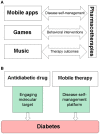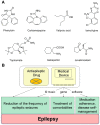Combining non-pharmacological treatments with pharmacotherapies for neurological disorders: a unique interface of the brain, drug-device, and intellectual property
- PMID: 25071711
- PMCID: PMC4095562
- DOI: 10.3389/fneur.2014.00126
Combining non-pharmacological treatments with pharmacotherapies for neurological disorders: a unique interface of the brain, drug-device, and intellectual property
Abstract
Mobile medical applications (mHealth), music, and video games are being developed and tested for their ability to improve pharmacotherapy outcomes and medication adherence. Pleiotropic mechanism of music and gamification engages an intrinsic motivation and the brain reward system, supporting therapies in patients with neurological disorders, including neuropathic pain, depression, anxiety, or neurodegenerative disorders. Based on accumulating results from clinical trials, an innovative combination treatment of epilepsy seizures, comorbidities, and the medication non-adherence can be designed, consisting of antiepileptic drugs and disease self-management software delivering clinically beneficial music. Since creative elements and art expressed in games, music, and software are copyrighted, therefore clinical and regulatory challenges in developing copyrighted, drug-device therapies may be offset by a value proposition of the exclusivity due to the patent-independent protection, which can last for over 70 years. Taken together, development of copyrighted non-pharmacological treatments (e-therapies), and their combinations with pharmacotherapies, offer incentives to chronically ill patients and outcome-driven health care industries.
Keywords: Mozart; chronic disease; depression; dopamine; epilepsy; fatigue; psychiatric disorders.
Figures


References
-
- Food and Drug Administration. Mobile Medical Applications: Guidance for Industry and Food and Drug Administration Staff (2013). Available from: http://www.fda.gov/downloads/MedicalDevices/./UCM263366.pdf
Publication types
LinkOut - more resources
Full Text Sources
Other Literature Sources

